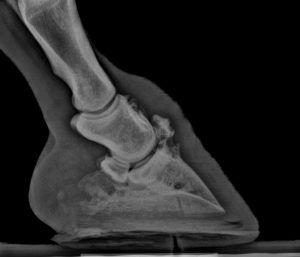Case Study – Horse with Low Ringbone
Farriers are presented with different horse feet scenarios. Often these come as a last resort from horse owners. This was a horse that was injured 4 months ago. The owner was not sure how the horse injured himself. There is a bulge at the coronary band and the right front foot is beginning to change shape. The foot has become narrower with a more pointed toe. A radiograph is a necessity. The owner considered the possibility of a tumor or abscess due to the bulge at the coronary band. This was ruled out once the veterinarian took the radiograph.
The radiograph re veals that the extensor process was fractured. This was the cause of the bulge at the coronary band. In older books this was called pyramidal disease since the extensor process was formerly known as the pyramidal process. This will develop into low ringbone located at the coffin joint. There is a small amount of calcification on the middle phalanx which is the beginning of high ringbone. Each scenario is different but typically the horse is the sorest when injured. As the calcification occurs through a deposit of an excess amount of calcium and phosphorous (exostosis), the area becomes hard with less continuous soreness. If the joint is involved the horse will be intermittently lame.
veals that the extensor process was fractured. This was the cause of the bulge at the coronary band. In older books this was called pyramidal disease since the extensor process was formerly known as the pyramidal process. This will develop into low ringbone located at the coffin joint. There is a small amount of calcification on the middle phalanx which is the beginning of high ringbone. Each scenario is different but typically the horse is the sorest when injured. As the calcification occurs through a deposit of an excess amount of calcium and phosphorous (exostosis), the area becomes hard with less continuous soreness. If the joint is involved the horse will be intermittently lame.
Shoeing treatment will not provide complete correction. The expectation of the horse ever being 100% sound is not possible due to the injury and damage and osteoporosis. Treatment is intended to help the horse be more comfortable and prevent or slow down the impending result. A regular trimming/shoeing interval is helpful. The heel was trimmed to take stress off of the extensor tendon and process. A bar shoe, rocker-toe was applied to provide additional relief as well as supplying support and length.
Generally when an injury occurs; the injured foot gets most of the attention. The white line on the left front was red, indicating stress and bruising to the laminae as it has begun to carry more weight due to the opposite foot’s injury. As a preventive measure a heart bar shoe was applied to share and transfer some of the weight to the frog. Often horses will develop a compensatory lameness as more weight is born on the unaffected limb and foot.
Not all horses are good patients especially when it hurts. This horse allowed the injured RF to be nailed on but was reluctant to give up the good foot (LF) when trying to apply the heart bar shoe. Farriers should be careful and not take any unnecessary risks. A sedative administered by the veterinarian may be a necessity.
The horse owner wanted to try and do all they could to make the horse comfortable. Information was gathered from veterinarian and farrier to help make their decision. The horse owner recognizes and accepts the probable future of inactivity of their horse. A commitment to go forward includes following instructions and regular shoeing intervals for the most desirable outcome.
Related Posts
-
©2013 Doug Butler PhD, CJF, FWCF Butler Professional Farri...Apr 10, 2013 / 0 comments
-
Farriers perform a valuable service for people who care abou...Jan 15, 2010 / 0 comments
-
©2013 Doug Butler PhD, CJF, FWCF Butler Professional Farri...Mar 21, 2013 / 0 comments
Blog Categories
- Anatomy
- Best Business Practices
- Conformation
- Current Events
- Customer Service
- Draft Horse Shoeing
- Equine Soundness
- Essential Anatomy Kit
- Farrier Careers
- Farrier training
- Foal soundness
- Horse Care
- Horse Foot Care
- Horse Owner Tips
- Horsemanship
- Horseshoeing
- Horseshoeing History
- Iron and Forge Work
- Student Spotlight
- Uncategorized
- Veterinary Care
Blog Archives
Contact Us
Butler Professional Horseshoeing School
495 Table Road
Crawford, NE 69339
(800) 728-3826
jacob@dougbutler.com
Subscribe to Our Blog
Get Our Free e-Book!
If you think you want to become a farrier (or know someone who does), this book can help you make that decision. Horse owners will learn the importance of choosing a qualified farrier and how to select the “right” one.
[ Get the e-Book Now! ]
- Follow:
